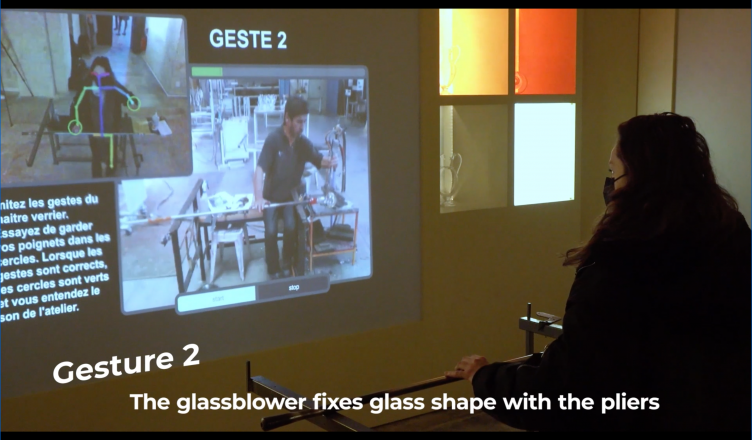Author: Anne-Laure Carré
About the Centre des Arts et Métiers
The Centre des Arts et Métiers (CNAM), Paris, France, hosts a museum of technological innovation and contains objects related to both the artistic and more industrial production of glass. Furthermore, it holds historic archives regarding the artefacts and techniques under study. All of these perspectives were harnessed in the Mingei pilot installation, which was open until the beginning of April 2022.
The pilot installation: training the public in glass blowing processes through re-enactment
The installation targeted craft presentation through an exploration of the workspace, as well as craft training through an interactive experience where users re-enact gestures of a glass master holding a tool and receiving audiovisual feedback on the accuracy of their performance. Preliminary evaluation results show high acceptance of the installation and good user interest.
Glasswork is a traditional craft that combines hand and body gestures and a thorough understanding of the material. It is a challenging craft because the material changes states from liquid to solid during production. While this complexity was not presented in the visitor-facing installation, in Mingei more broadly we pushed forward the technical means for capturing and conveying these sensory aspects of glasswork, that is to say, the requirements of dexterous aspects and tool manipulation in craft presentation and preservation.
Learning and iterating: what we learned from user-experience evaluations
After the technical validation of the installation, we conducted a short preliminary evaluation with museum personnel. The first part of the preliminary evaluation was conducted with users from the education department of the museum who were invited to experience the installation and mimic the craftsperson actions using the bench and tools provided. What was learned led to changes to the user-interact (UI) to (a) provide real-time help to users to guide them through the training process and (b) enhance the feedback users get while using the app to better understand whether they are copying the movements right or wrongly. We fixed a glitch that meant that users sometimes thought they were doing it wrong because the feedback came too slowly. stopped with the application because they didn’t receive fast enough, and instead thought they were doing it wrong.
A wider evaluation with visitors was conducted later. We asked a user-experience evaluator to monitor how users interacted with the installation. Minor issues with the UI were improved, including the addition of introductory screens to assist users to know when the presentation element had finished and when the training session was beginning (and when they were expected to get active).
Responses from museum visitors
There were regular visitors to the installation, located as it was in part of the impressive church in the museum building, Saint-Martin-des-Champs. An audio component meant that the installation piqued the interest of those outside.
Feedback collected via our post-interaction questionnaire showed that what seemed to impress visitors the most was the whole concept of being able to mimic the gestures, or as one of the visitors characteristically wrote “being in the shoes of the glassmaker” and receive feedback on the accuracy of the movement in real-time. Using a real-life workbench and glass blowpipe only added to the authenticity of the represented scene and further enhanced the whole user experience.
Find out more for yourself in the video below and explore the digital presentation of glass-blowing on the Mingei Open Platform.

